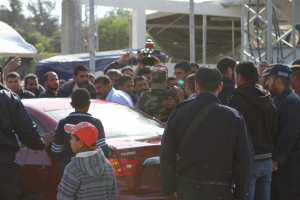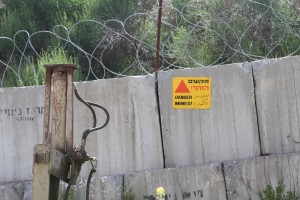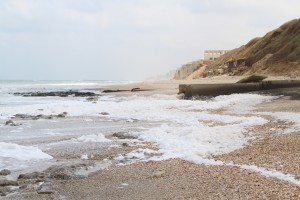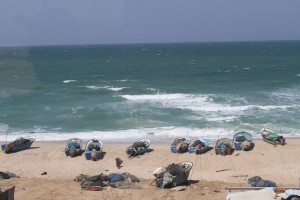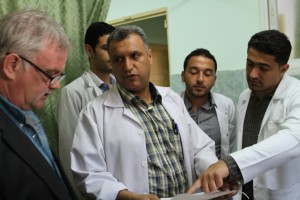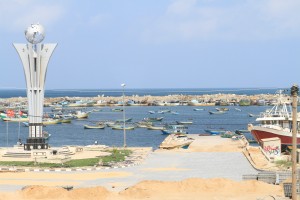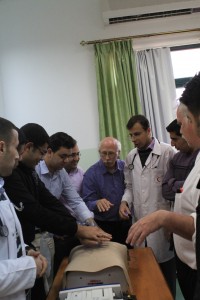Leaving Gaza – Thoughts from four of the people who joined our delegation
(Gerri Haynes, former president of Washington Physicians for Social Responsibility, returned to Gaza with a delegation of doctors, nurses and others interested in helping the people there. Gerri has been sending back reports and this is her last one, at least until the next delegation.)
“Where are you from?” “Am’rika”, I reply.“Welcome, welcome”. Time and time again, the same warm, hospitable message.
My stay in Gaza started with the surreal witnessing at the Hamas border of the Islamic jihad and Mujahideens welcoming a prisoner back home to Gaza after having spent 27 years in an Israeli jail. Men in full balaclavas with Kalashnikovs, shots fired in the air in signs of happiness, family, journalists. We hadn’t asked for such a fervent welcoming committee… 😉
In the countryside, the peace sign is constantly flashed when we drive by. Yet Gaza is anything but peaceful. Torn to its core by continuous wars, the latest in November of 2012, Gaza is a place on edge, where people talk about their frustration with the government as well as with their neighbor Israel. The ever-present dust and destruction permeate my daily life, it exhausts me. Everywhere my eyes track, I see iron rods sticking out of concrete rubble, dirt and garbage everywhere, plastic bags flying, chaos—it’s inescapable, pervasive. Nothing is green. Graffiti covers almost every wall at every corner of the streets –it’s truly an art form intrinsic to Gaza—their unique message a plea for peace and the right to their land. It is exhausting and depressing. To my eyes, unused to war and destruction, the bombings could have happened yesterday – so intense is the devastation –yet to the ones who know, Gaza is purportedly doing some rebuilding. But many things have sadly just stayed the same here, or even gotten worse, paralyzed by systemic inefficiencies, political rifts and economic blockade.
With its 1.7 million inhabitants (most of them refugees)squeezed in less than 360km), Gaza is one of the most overcrowded places on earth. Blockaded since 2007 when Hamas gained power and controlled by the Israeli Defense Forces by air, sea and land, Gazans experience hardships very few can imagine: unable to leave, they remain in an open-air prison that boasts over 34% unemployment and 80% of its population on some form of aid. Compounding this situation are a fledgling infrastructure, severe electricity shortages, massive water issues, a struggling municipal service and a state of constant economic squeeze. You may understand a little better why peace is a difficult concept here.Yet, against this backdrop of people exhausted in the struggle to survive, their resilience and kindness take over. “We are so sorry for what happened in Boston”. How many times did I hear this message?
The cacophony of horns, generators or street vendors selling their goods to the passers-by signal that life still goes on in Gaza. Driving is mayhem, with cars weaving in whichever direction, honking their horn incessantly, asking whether you need a ride. I am the rare foreigner here—one of the only women in this sea of humanity who does not wear a scarf over my head. Walking in the streets in the old souk, I am undoubtedly noticed; the young men want a picture with me. “Welcome, welcome.”
I am their window to the outside. Every day, I have been touched by their gestures of generosity: the pita baker at the street corner invites me to make pita in his oven, and then gives me bread; my falafel hangout feeds me more falafels than I can digest – and wants to marry me; our staff at the hospital brought plates of fresh humus and olives for breakfast. They have kindly taught me Arabic words, enough that I can get my “café aulait” in the afternoon. I have been served more coffees and teas than I could dream of. At work in the hospital, they have taught me how much they can do with so little. They always readily share everything they have – and with a smile.
Even if deprived of their dignity, Gazans cannot stop having hope. It is their only option. And they know it all too well.Today was my last day at El Shifa hospital – today was a day of optimism. I witnessed two babies being born – two human beings who know nothing about war and conflict. As a new generation is born, each and every one of us, no matter our beliefs, owes it to them to have the right to a future as bright as ours. It is their right as human beings.
Kit Kittredge writes:
I found Palestinian resilience, resourcefulness and resistance alive in the streets and health facilities I worked in during this visit to Gaza.
The physiotherapy clinics are staffed with friendly, competent, committed staff doing great work and willing to share their knowledge and skills as well as learn some of ours. Additionally in the women’s and children’s clinics I found a very weary, stressed and anxious population. I saw many cases of children severely burned from gasoline and candle fires due to electricity shortages from Israel. I worked on children with missing limbs from explosives and phosphorous gas, and unwarranted amputations due to limited emergency care during Israeli attacks.
The illegal, immoral, barbaric siege of Gaza permeates every aspect of the medical community. The destruction of facilities, blockade of supplies, restricted access to definitive care, and the constant threat of an Israeli attack are horrific enough, but the psychological warfare is as destructive and intentional as the bombs.
Amidst the oppression and terror , the Palestinian spirit continues and the medical community works tirelessly and strives to meet the needs of the people. As always I am continually amazed, humbled and inspired by the people of Gaza. They are more than capable and willing to create a sustainable, peaceful, vibrant country if only we allow them to by helping end the U.S. supported Israeli blockade.Keith Meyer writes:
I worked with the physical therapy departments of El Waffa , Shiffa, and Public Aid hospitals and a private acupuncture clinic and found their staff and facilities well run. The staff was plentiful and well qualified but sadly there are not enough supplies or equipment to service the people’s needs due to the Israeli blockade, which is supported by Egypt and the U.S. The people I worked with and met on the street love life, family and friends.
After the Boston Marathon bombing all the therapists and doctors expressed their deepest sympathy and stated that they, of all people, understood our loss. As anticipated the people of Gaza were gracious, kind and generous. This was my first time in Gaza so there was some anxiety about what I would see versus what I have heard and read in the media.
The people of Gaza that I met and worked with hold education as very important. One Gazan said he was told by his grandparents, “You can lose your home, your land and all your possessions, but they can not take what you carry in your mind. You can take your education with you and use it anywhere.” This sentiment was echoed by all Gazans I spoke with. It saddened me to see the conditions in which they are forced to live, but I was inspired and moved by their resolve to work and live with integrity and love in their hearts.
And Bill Dienst writes:My first visit to Gaza was in 1985 and this is my seventh trip to the region. In the 80’s,there were no substantial physical barriers between Gaza and Israel. Many Gazans worked as day laborers in Israel and many spoke Hebrew. Group taxis traveled freely between East Jerusalem and the West Bank, and directly into Gaza City. The society here in Gaza was much moreWesternized and secularized than it is today. Women wore blue jeans and ponytails, and the hijab and the naqab were not nearly as ubiquitous as they are now. But it was hardly a perfect relationship between Israelis and Palestinians; more of a privileged class and servant class based on the birthright of whether or not one was born Jewish. But there was abundant interaction between the two societies then.
Then came the First Intifada (shaking off or uprising) and then the Oslo “Peace Process” which was really a “Piece Process.” This culminated in the division of the two societies and the isolation of Gaza from the rest of the world. There was false hope then and a second intifada. Gaza was locked down as a consequence and became the world’s largest prison.
When I re-entered Gaza some 18 years later in 2003, it was a much different world. Dr.Haidar Abdul Shafi, a respected physician and civic leader in Gaza, explained to me why he had walked out of the Madrid Peace negotiations in 1991. “I concluded that the Israelis we renegotiating in bad faith,” he said. It took me a while to fully understand what he was talking about, but slowly it became clearer. Gaza was now surrounded by a hideous “Berlin Wall”. Rachel Corrie had just been mowed down by a giant bulldozer. Houses and apartment blocks were being systematically destroyed under the orders of Ariel Sharon “to look for tunnels”. Many tunnels were found and destroyed, but even more tunnels were built in their place and remain today. More than2000 people in Rafah were made homeless as a direct result of Israel’s pursuit of the tunnels.
In 2006 I entered Gaza during a time of assault. The streets of Beit Hanoun were ripped apart after a Qassam missile had killed an Israeli woman in Sderot. More than 85 Palestinians were killed in Beit Hanoun and nineteen members of the Al Athamna family were massacred as they slept in their beds. Iinterviewed some of the grief stricken survivors a few days after the onslaught. Apache attack helicopters reigned death and destruction from the skies directly above us; we rushed to the Kamal Adwa Hospital to assist local doctors as 5 young men in their 20s died right in front of us. It was a time of palpable fear for me, as I shared for the first time, the fear that local Gazans feel routinely.In 2008, I entered Gaza by boat. I was part of the maiden voyage of the Free Gaza Movement; we were the first boats to arrive from international waters in 41 years. Gaza had been under a tightening siege. There were40,000 people on the shores of the Gaza Marina waiting to greet us. It was a time of euphoria as we demonstrated to the people of Gaza that many of us around the world have not forgotten them; many around the world who do care about them. There were several more boat trips and then flotillas. Then there was the massacre on the Mavi Marmara. My Italian friend Vittorio Arrigoni was martyred two years, and he is still remembered by the people of Gaza.
Then came the horror of Cast Lead. I last entered Gaza again in October2009 in its aftermath. The streets were filled with entire blocks of rubble; neighborhoods had been leveled; the siege had been tightened and there were no materials for rebuilding. Dr. Marwan Assalya, the general surgeon at Al Awda Hospital where we were assigned, shared horrific photographs of people he had cared for during the previous winter. There were pictures or victims of white phosphorus attacks with second, third and fourth degree burns all over their bodies. There were recipients of DIME weaponry whose arms were sheared off by vaporized micro-shrapnel. Patients who survived lingered, only to succumb later to sepsis; or if they survived in the short term, succumbed later to cancer – probably a direct result of the tungsten heavy metal vapor supplied by the U.S. arms industry. There were pictures of drone victims who had had both legs blown off; these were the survivors; there were no pictures of those who died immediately in the attacks.So now we are in Gaza. Our medical team disperses to various assignments. Dr. Bob Haynes and I are teaching elements of Advanced Cardiac Life Support at Shifa and Public Aid hospitals. We are giving lectures to very bright young medical and nursing students at Al Azhar and Islamic Universities.
We are being greeted by smiling and attentive students who still show hope and amazing resiliency for their future. In Gaza, hope springs eternal – Phoenix keeps rising miraculously from the ashes, especially among the youth.
But we will keep coming back as long as we can.
RSS feed for comments on this post. TrackBack URI
